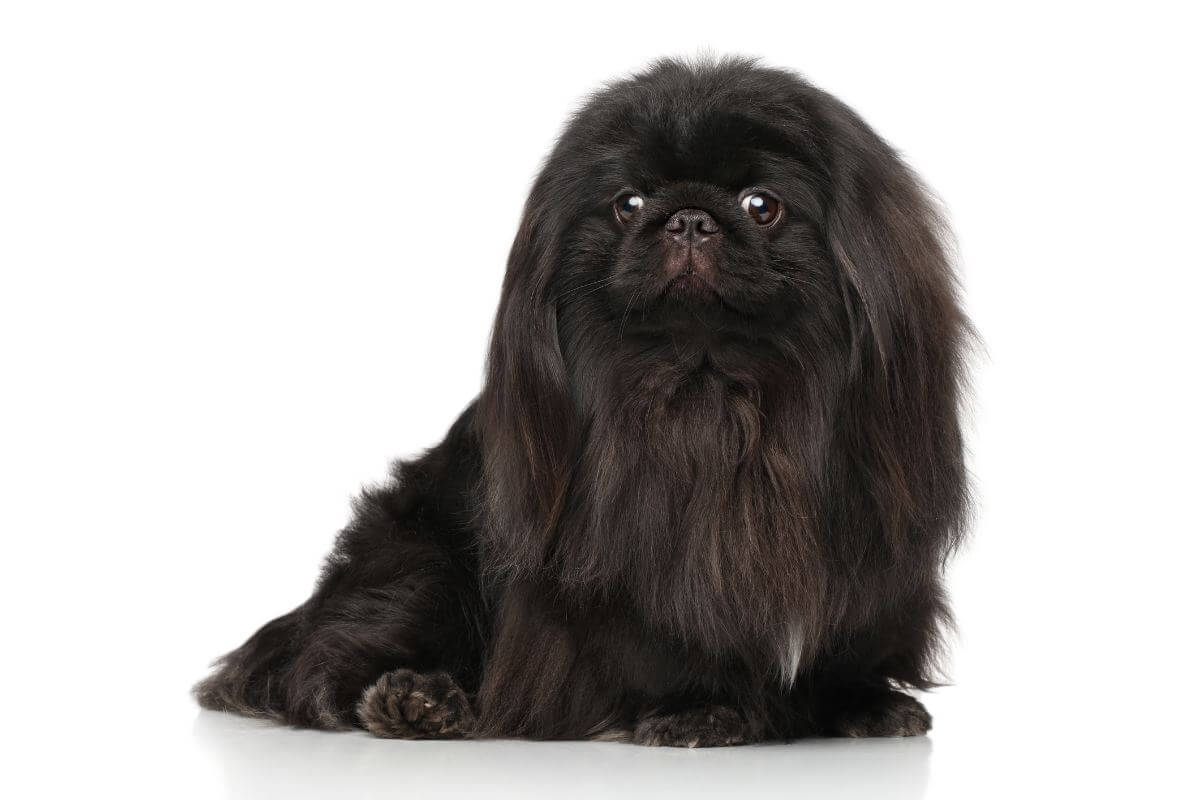
Home » The Hard Colors

This article was originally published in Showsight Magazine, February 2015 issue.
The Pekingese Standard was revised in 1995, and the statement regarding color now reads:
“All coat colors and markings, including parti-colors, are allowable and of equal merit.”
Obviously, this includes whites, creams, and blacks as well as the parti-colors. Whites and creams have long been thought to be inferior to the other colors. Most of us have seen “white pet store Pekingese” that leave a lot to be desired, and this has negatively influenced judges’ appreciation of this color. Likewise, partis and blacks have taken a backseat in the past.
A parti-color should have equal amounts of both colors on the body. Therefore, a dog with a shawl over the shoulders and white on the chest is NOT a parti-color. A cream Pekingese is one that has only one color on the coat and face. A pale fawn with some color on the ears or face is NOT a cream. Whites come in various shades but are a shade of white, not cream. Lootie, one of the first Pekingese we see in prints, was a parti-color. This is a color that is very seldom seen in the show ring today. The same can be said for black and tan, a color that we seldom see.
Blacks have made headway in the last ten years due to the efforts of several dedicated breeders and are now more accepted in the ring. How about white? Up until the past several years, this is a color that has not often been seen in the ring, or if it was, it was quite inferior to the other colors. Is it possible to breed a white that is on an even par with the other colors? I think it is. I have been breeding for over 45 years and have produced over 125 Champions, including at least 30 whites. As you can tell, I am addicted to the white Pekingese, and it has become my goal for the past 15 years to breed them to a quality equal to the other colors.
First of all, you must realize that the gene pool for whites, or blacks, or partis, is much smaller than that of the “normal” colors. Because of this, we will probably have to be more careful about how we breed, and my emphasis has always been on improving quality. Where do you go to get started on this venture? Since I had several nice creamy white bitches in my kennel, thanks to a strong white gene that one of my best males carried, I proceeded to search for the best white male I could find to mate them to.
I decided that I was not going to find that in this country but managed to find one in England. This was the key that I needed to seriously get started on this project. I might add that I had dabbled in this project at least twice prior to this but never had the right key!
This was the starting point that pointed me in the right direction toward success. The same goes if blacks, black and tans, or partis are your passion. Find the best, and breed to the best, and keep studying. Now, getting back to the small gene pool, it is going to be necessary to bring in quality from the very best of the other colors. Doing it this way is going to take a little longer, but the outcome will be much more pleasing.
To breed only for color is a mistake. What is it going to take to get the judges to acknowledge that a white, or black, or parti can be comparable to the other colors? That’s easy. We must show them only quality exhibits. It is necessary to be able to stand back and objectively say, “Is this a dog that I would show if it were any other color?” If the answer is “yes,” then go for it! I don’t ever want to hear the statement again: “It’s pretty good—for a white.” We are all used to seeing a “normal” colored Pekingese with a black mask, so we find it easier to analyze their facial structure. Color on the face, or lack of it, can be very deceiving. A black mask can often accentuate desired features, which can be more difficult to appreciate in a self-masked dog. There is also quite a difference between dogs with full black faces and black muzzles. Coat color also plays a part in how you perceive the total package. Your eye will be immediately drawn to the clear colors with black on the face. You must learn to look past color and consider what is beneath the coat.
I would like to ask all the people who judge Pekingese to keep an open mind and not discount any dog just because of its color. Try to get past the color, judge according to the Pekingese Standard, and judge the dog on the day. Sooner or later, the hard colors will take their place along with the other colors as quality exhibits.